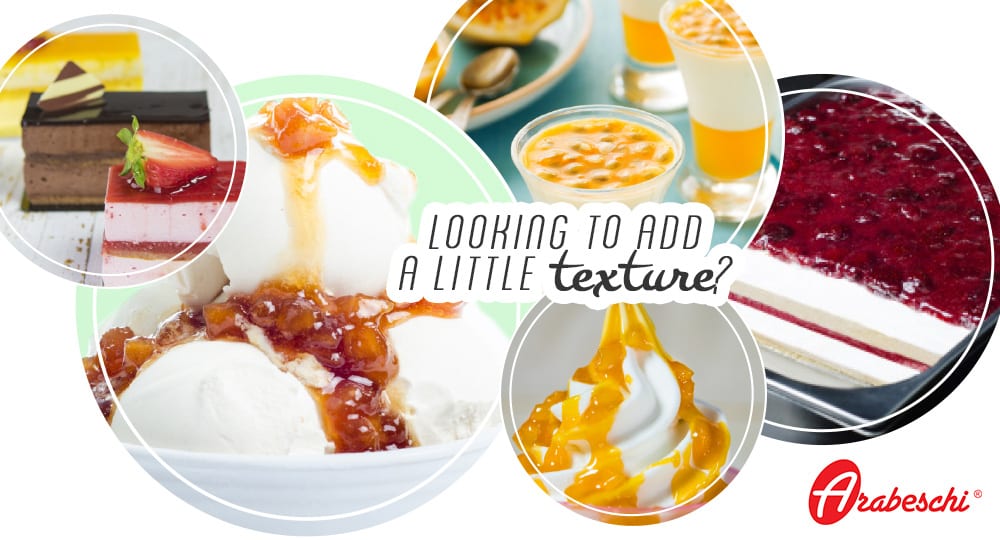Adding Texture to Desserts

There’s vanilla gelato, and there’s vanilla gelato with crunchy chocolate cookie pieces. There’s green mint ice cream, and there’s “melt-in-your-mouth” mint chocolate chip ice cream. There’s cheesecake, and there’s turtle cheesecake with gooey caramel sauce, crunchy chocolate morsels, pecan bits, and grainy graham cracker crust. Magic!

By now you’ve got the point: the texture of our food (smooth, creamy, crunchy, grainy, chewy, rubbery, slimy, etc.) makes a big difference in what we choose to eat, how much we will enjoy it, and why we make those choices to begin with. This new discovery leads to the term of the day: rheology, or food texture. I was personally surprised that there was scientific terminology for this and quite captivated by the intricacies surrounding food rheology.

A little bit of this, a little bit of that…
If you’re a fan of the movie Fiddler on the Roof like me, you may have picked up on the title of this segment. And though the particular song these lyrics reference have nothing to do with recipe development, they lend themselves well to the topic of food texture. Adding a little bit of this, and a little bit of that to a recipe can excite psychorheology. Yes, it’s a thing!
Well, what is psychorheology?
According to www.popsci.com, the digital publication of Popular Science, psychorheology is the perception of food’s rheology, which focuses on the consistency and flow of food. And the best way to perceive our food is through our chewing preferences, of which there are four categories according to a group of food sensory researchers from The Understanding & Insight Group.
So, if you’re curious about the types of chewing preferences your consumers (or you) favor, check out this list:
- Smoosher: those who prefer soft, creamy foods that move around the mouth with little to no actual chewing like pudding, applesauce, yogurt, smoothies, and hummus.
- Chewers: those who prefer foods that can be chewed for a long period of time such as dates, gummy candies, dried fruit, and fruit leather.
- Crunchers: eaters who prefer foods that…crunch, much like chips, pretzels, popcorn, granola, graham crackers, apples, carrots, and pumpkin seeds.
- Suckers: this group prefers foods that slowly dissolve over time, much like hard candy, frozen pops, and cotton candy.
Why is this important to know?
Because, contrary to popular understanding, the overall appeal of food does not wholly depend on taste (the senses inside our mouths including the tongue), flavor (when taste and aroma merge), and smell. But how a food feels can affect our enjoyment of what we’re eating. Mouthfeel, how food or drink feels inside our mouths, is just as important as flavor, taste, and smell to the entire dining experience.
So, how can I enhance the rheology of my menu choices?
Inclusions are the not-so-secret enhancer of delicacies across the board. Think fresh fruit, nuts, pieces of chocolate, etc., or variegates, toppings, and fillings capable of combining all of these components in one. Consumers are naturally attracted to “pretty” or interesting things, which is why we normally eat first with our eyes, right? So, the use of sauces with inclusions easily elevate the average recipe’s visual appeal…and more. Sure, consumers know what core flavors they crave, but it’s that extra bit of “umph” provided by methods like using sauces with textural elements that seal the deal.
You’re right. Showing examples always helps!
Today, adding food texture is not only good practice to ensure you satisfy any of the four segments of chewing preferences, but adhering to dietary restrictions, and beautifying your creations are all current trends surrounding rheology (food texture), and psychorheology (the perception of food texture).

According to a report published by Mintel, a global provider of market research, some of today’s hottest food trends showcase the addition of variegates, toppings, and fillings as the stars of some irresistible-to-look-at treats. If I argued the fact that the inclusions are the reason why these trends are so popular, would you agree?
Take the following examples of upgraded food rheology for instance:
Freakshakes/Monstershakes – In this instance, Mintel notes that loading works with appetizers such as loaded French fries, chips, nachos, and the infamous loaded potato. But now freakshakes/montershakes are following suit, except with a jambalaya of dessert sauces that dazzle all the senses at first sight!
These “beverages” could easily be described as a family-style dessert in a single glass, boasting outrageous loading and layering of varying sauces with different textures, including crunchy, gooey, smooth, or more, no doubt adding limitless appeal.

Dietary restrictions – In terms of gluten-free menu items, Mintel has reported a 30% increase between 2015 and 2017; regarding vegan/vegetarian items: +45%. Whether kosher, halal, vegan, gluten-free, etc., dietary restrictions are ingrained in our culinary culture. However, this does not prohibit the inclusion of textural upgrades, so long as the ingredient you choose has the dietary certification you need. It’s important to keep in mind that adding texture is only a delicacy if it can be enjoyed. That means keep your recipes 100% of what your intended outcome is for the consumer you are serving.
Seasonal – Consumers are consistently drawn by labels like locally-sourced, limited time only, and seasonal. In terms of seasonal, Mintel states that it is the seventh leading menu item claim and continues its popularity in the ongoing climate favoring seasonal cuisine. They add that the term doesn’t just apply to fruit. When used in a general dessert title, it implies that the ingredients call on the time of year—implying freshness and perhaps local. Mintel suggests that seasonal cobblers and sorbets fit well in this category.
Bonus point: Recipe inclusions, such as variegates, toppings, and fillings add the taste of ripe, sweet, seasonal ingredients any time of the year.
Other examples of trending foods are donuts, which are steamrolling through the foodservice industry, showcasing an endless variety of flavors and textures to choose from. This silo has shown an enormous amount of growth and imaginative recipe innovation since the days of the simple cake donut.
All kinds of fruity, crunchy, gooey, creamy, enjoyably grainy textures have helped the American donut (or doughnut, whichever you prefer) to achieve the coveted place of esteem it as achieved in the dessert world.
They have successfully transitioned from a basic breakfast item to an anytime-of-the-day treat.
Nowadays, donuts are still mobile and can easily be dunked into a cup of coffee, milk, or latte, but with all the heightened food texture, or rheology taking place, one just may need a knife and fork to finish off these increasingly evolving goodies.
With that said…
Author Malcolm Bourne of Cornell University wrote that people have a “deeply ingrained need to chew.” He also noted that crispy, creamy, and chewy are the three most relished texture notes.
Inclusions like dessert sauces with textural elements can satisfy a consumers need to chew (whatever their chewing preference), and offer more variety than only the “most relished” texture notes.
Adding more texture to your recipe development has proven to bring increased enjoyment to the overall dining experience for your consumers. Of course having the right partner to supply quality ingredients with textural elements that deliver color, taste, flavor, aroma, and décor is equally as important to your establishment as crafting unforgettable recipes.

Did you enjoy the exploration of rheology and psychorheology? If so, you should check out the brochure of variegates, toppings, and fillings below. Remember: a little bit of this, a little bit of that (or a lot of this and that when you’re making monster shakes) makes for a remarkable culinary experience that regular and new consumers will appreciate.






